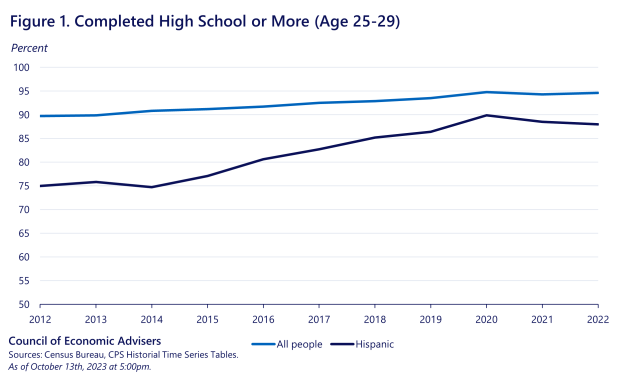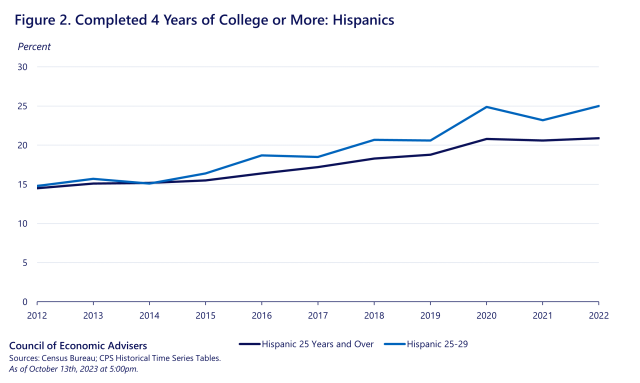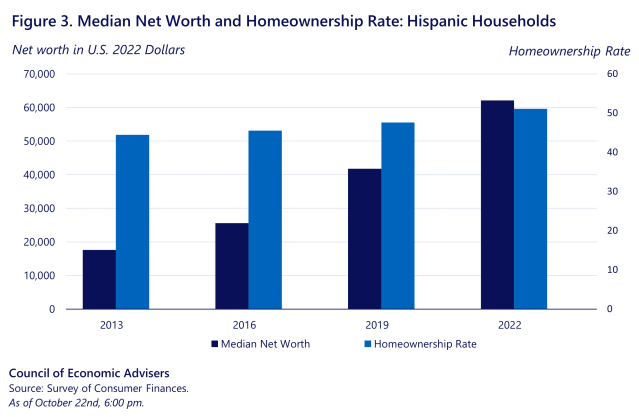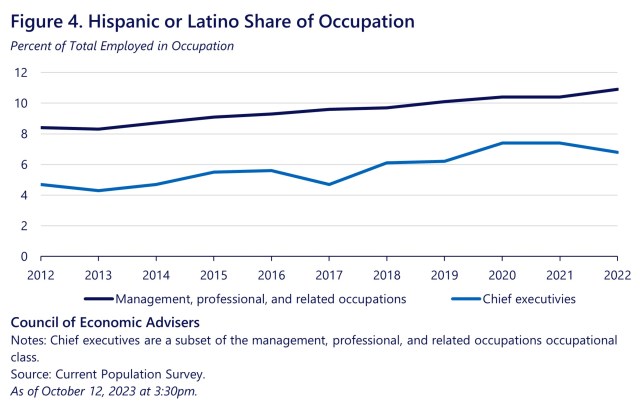In celebration of Hispanic Heritage Month, this blog post highlights several recent economic achievements of the Hispanic community in the United States.
1. High school completion among Hispanics is increasing.
To begin, we look at educational attainment, which forms a foundation for other forms of economic advancement. Hispanics have made great strides in both high school and college educational attainment over the past decade (Figure 1). In 2022, 88 percent of Hispanics age 25-29 held at least a high school diploma, up 13 percentage points (17 percent) from 2012. In addition, the gap in high school completion between Hispanics and the overall population has been cut in half, from about 15 percentage points in 2012 to about seven in 2022. Although some of these recent gains in completion have been lost because of the pandemic, the overall trend strongly demonstrates that Hispanic education attainment is increasing.

2. A growing share of Hispanics are completing a four-year college degree.
Hispanics are completing college at higher rates relative to earlier years as well (Figure 2). The percentage of Hispanics 25 and over in the US who hold a four-year college degree has increased by 5 percentage points (44 percent) over the past decade. Among 25-29 year-olds, the percentage has increased by 10 percentage points, an astounding 69 percent gain since 2012. The Biden-Harris Administration remains consistent in its goals to promote educational opportunity and diversity in post-secondary school education.

3. Hispanic households are increasingly likely to be homeowners and have tripled their net worth over the last decade.
One way in which education leads to economic achievement is by opening up opportunities to create wealth. Growth in the median wealth of Hispanics has been dramatic in recent years (Figure 3). From 2013 to 2022, median inflation-adjusted wealth of Hispanic families in the US more than tripled, from $18,000 to $62,000. The rate of home ownership among Hispanic families increased by more than 6 percentage points over this period, and the rate of Hispanic business ownership nearly doubled. Although the percentage increase in median wealth over the 2013-2022 period was larger among Hispanic households than among other racial or ethnic groups, there remains a sizeable wealth gap between Hispanic households and all households. Continued progress in education and economic opportunity remains important to closing this gap.

4. Hispanics increasingly occupy professional leadership positions at US firms.
Finally, Hispanics continue to expand their role in management and business leadership in US firms, consistent with an overall increase in the diversity of those occupations (Figure 4). Since 2012, the percentage of workers in management, professional, and related occupations who are Hispanic has increased from just over 8 percent to nearly 11 percent, while nearly 7 percent of chief executives are Hispanic. Representation in leadership positions is important not only because these occupations are high earning or because more diverse leadership is associated with improved business performance; increased representation matters because exposure to underrepresented groups, including exposure to individuals in leadership roles, can reduce discrimination. The increase in Hispanics in such leadership roles opens up opportunities for continued economic advancement.

The continued success of Hispanics reflects the hard work and investment of the community. It also reflects the importance of economic institutions and policy choices that support shared prosperity. A continued focus on steady economic growth, strong institutions, and effective policies will help to ensure that this progress continues.
Source: The White House















